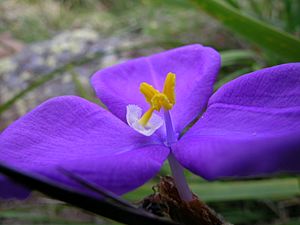Purple flag facts for kids
Quick facts for kids Purple flag |
|
|---|---|
 |
|
| Scientific classification | |
| Genus: |
Patersonia
|
| Species: |
sericea
|
Patersonia sericea, often called the purple flag, native iris, or silky purple flag, is a beautiful plant. It belongs to the iris family, called Iridaceae. This plant is special because it is endemic to eastern Australia. This means it naturally grows only in that part of the world. It's also quite easy to grow in gardens. In fact, one of the first plants studied by the scientist Robert Brown came from seeds grown by a company in London, which got the seeds from Port Jackson in Australia.
Contents
What Does the Purple Flag Look Like?
The purple flag is a perennial plant, which means it lives for more than two years. It's a herb that grows in thick clumps. It can reach about 60 centimeters (about 2 feet) tall.
Its leaves are stiff and stand straight up, looking a bit like grass. They are 15 to 60 centimeters long and 2 to 6 millimeters wide. The leaves are smooth, except for tiny hairs along their edges. Near the bottom, they have short white hairs.
The flower stalk can be 3 to 55 centimeters long. The petals are a lovely blue-violet color. They are shaped like ovals, about 20 to 30 millimeters long and 15 to 25 millimeters wide. Purple flag flowers bloom in spring and summer. Each flower is special because it only lasts for less than one day!
How Did It Get Its Name?
The Patersonia sericea was first officially described in 1807. This was done by a famous botanist named Robert Brown. He wrote about it in a science magazine called Curtis's Botanical Magazine.
The second part of its scientific name, sericea, comes from a Latin word. The Latin word sericus means "silken." This name was chosen because of the silky hairs found at the base of the young leaves.
Where Does It Grow?
The purple flag plant grows naturally in several parts of Australia. You can find it in Queensland, New South Wales, and Victoria (Australia).
It likes to grow in dry sclerophyll forests, woodland areas, and heathlands. These are places with tough, often spiky plants that can handle dry conditions. The purple flag prefers sandy soil that drains water well. It is often found along the coast and in mountain ranges.
Is It Safe in the Wild?
Good news! The Patersonia sericea is not considered to be in danger in the wild. This means there are enough of these plants growing naturally, and they are not at risk of disappearing.
Can You Grow Your Own Purple Flag?
Yes, you can! The purple flag is a great plant for gardens. It grows well in hot and dry places. It can also handle frost, which means it won't be damaged by cold temperatures.
It looks really nice when many purple flag plants are grown together. They can create a beautiful bed of perennial plants in a garden.
Who Eats the Purple Flag?
The Patersonia sericea is an important food source for some animals. Two types of butterflies use this plant as food when they are caterpillars (larvae). These butterflies are the eastern iris-skipper ((Mesodina halyzia)) and the montane iris-skipper ((Mesodina aeluropis)). They rely on the purple flag to grow and become adult butterflies.

